Gary Nichols. Sedimentology and Stratigraphy(Second Edition)
Подождите немного. Документ загружается.

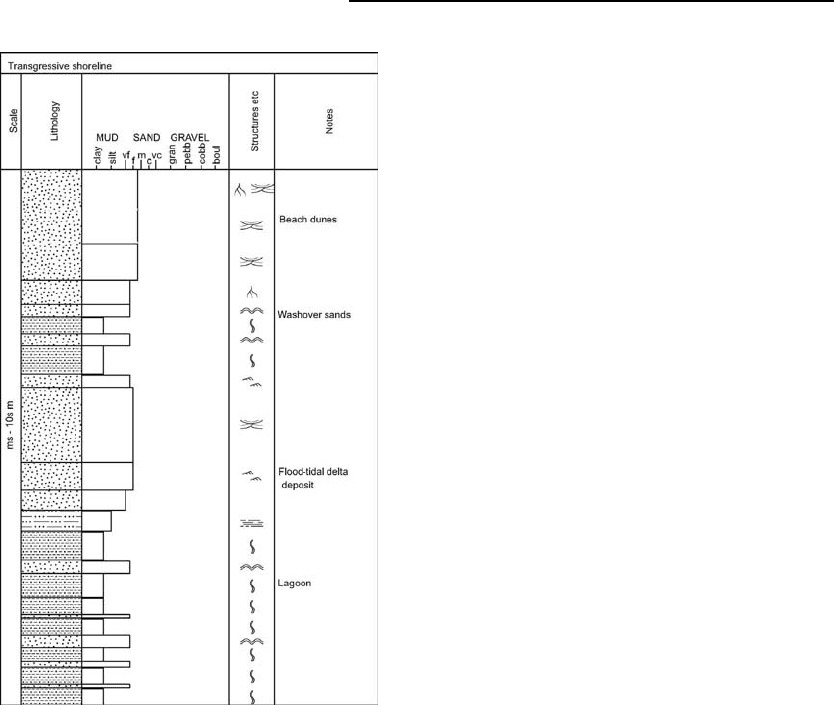
relative rise in sea level (a transgression, 23.1.3).
They are regions of mixing of fresh and seawater.
Sediment supply to the estuary is from both river
and marine sources, and the processes that transport
and deposit this sediment are a combination of river
and wave and/or tidal processes. An estuary is differ-
ent from a delta because in an estuary all the sedi-
mentation occurs within the drowned valley, whereas
deltas are progradational bodies of sediment that build
out into the marine environment. A stretch of river
near the mouth that does not have a marine influence
would not be considered to be an estuary.
Estuaries are common features at the mouths of
rivers in the present day because since the last glacial
period there has been a relative rise in sea level.
During this Holocene transgression many river
valleys have become flooded and these provide a
spectrum of morphologies and process controls that
can be used to construct models for estuarine sedi-
mentation. Two end members are recognised (Dal-
rymple et al. 1992): wave-dominated estuaries
and tide-dominated estuaries, with a range of inter-
mediate forms in between. In addition to these two
basic process controls, the volume of the sediment
supply and the relative importance of supply from
marine and fluvial sources also play an important
role in determining the facies distributions in an
estuarine succession. The extent of estuarine deposits
will depend upon the size of the valley and the depth
to which it has been flooded. Modern estuaries range
from a few kilometres to over 100 km long and from
a few hundred metres to over 10 km wide. The thick-
ness of the succession formed by filling an estuary is
typically tens of metres.
Sedimentation in an estuary will eventually result
in the drowned valley filling to sea level and, unless
there is further sea-level rise, the area will cease to
have an estuarine character. If there is a high rate of
fluvial sediment supply, deposition will start to occur
at the mouth of the river and a delta will start to form.
Under conditions where the marine processes are
dominant, the river mouth will become an area of
tidal flats if tidal currents are strong, or the sediment
will be reworked and redistributed by wave processes
to form a strand plain. An estuary is therefore a
temporary morphological feature, existing only dur-
ing and immediately after transgression while sedi-
ment fills up the space created by the sea-level rise.
The presence of estuarine deposits therefore can be
used as an indicator of transgression – see Chapter 23
for further discussion of the relationship between sea-
level changes and facies.
13.6.1 Wave-dominated estuaries
An estuary developed in an area with a small tidal
range and strong wave energy will typically have
three divisions (Figs 13.13 & 13.14): the bay-head
delta, the central lagoon and the beach barrier.
Bay-head delta
The bay-head delta is the zone where fluvial pro-
cesses are dominant. As the river flow enters the
central lagoon it decelerates and sediment is
Fig. 13.12 A schematic graphic sedimentary log of a
transgressive coastal succession.
208 Clastic Coasts and Estuaries
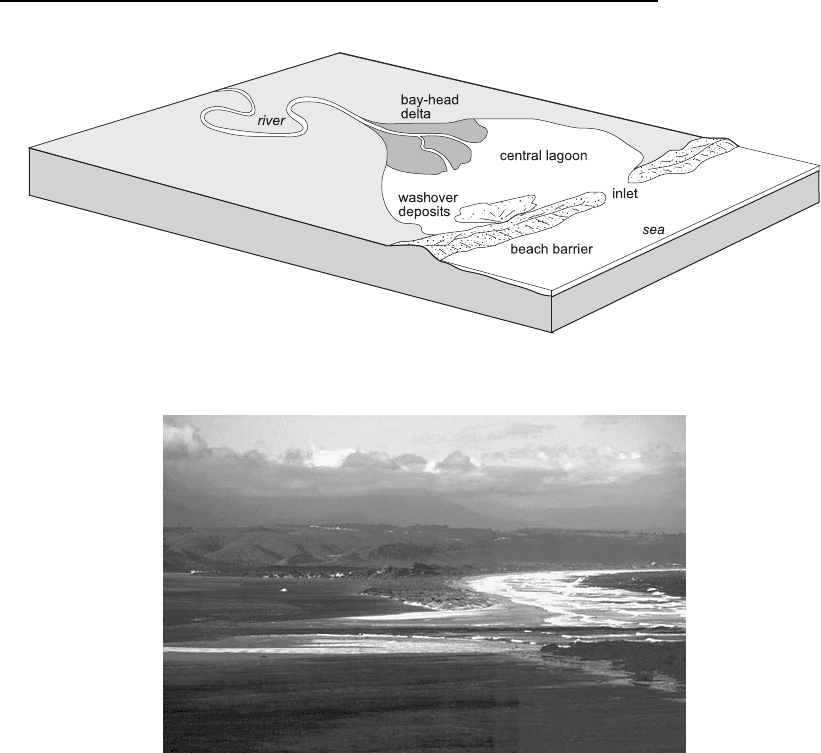
deposited. The form and processes of a bay-head delta
will be those of a river-dominated delta (12.4.5)
because the tidal effect is minimal and the barrier
protects the central lagoon from strong wave energy.
A coarsening-up, progradational succession will be
formed, with channel and overbank facies building
out over sands deposited at the channel mouth,
which in turn overlies fine-grained deposits of the
central lagoon.
Central lagoon
The lowest energy part of the estuarine system is the
central lagoon, where the river flow rapidly de-
creases and the wave energy is mainly concentrated
at the barrier bar. The central lagoon is therefore a
region of fine-grained deposition, often rich in organic
material, similar to normal lagoonal conditions
(13.3.2). When the central lagoon becomes filled
with sediment it becomes a region of salt-water
marshes crossed by channels. In wave-dominated
estuaries, parts of the lagoon that receive influxes of
sand may be areas where wave-ripples form and these
may also be draped with mud.
Beach barrier
The outer part of a wave-dominated estuary is a zone
where wave action reworks marine sediment (bio-
clastic material and other sediment reworked by
Fig. 13.13 Distribution of depositional settings in a wave-dominated estuary.
Fig. 13.14 A wave-dominated estuary, with an extensive beach barrier protecting a lagoonal area.
Estuaries 209
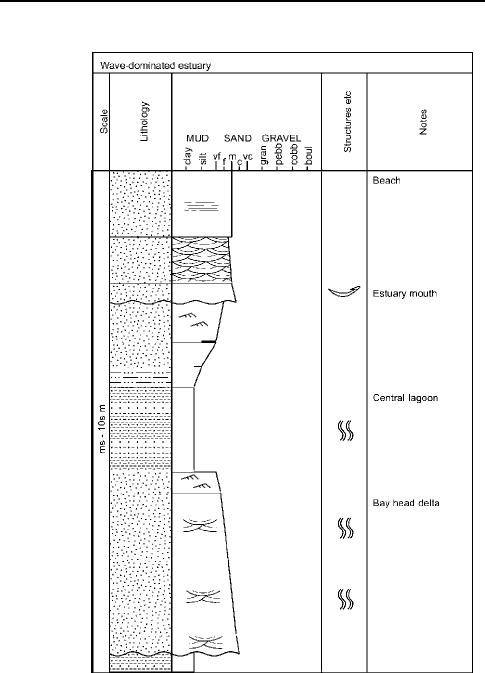
longshore drift) to form a barrier. The characteristics
of the barrier will be the same as those found along
clastic coasts (13.3.1). An inlet allows the exchange
of water between the sea and the central lagoon,
and if there is any tidal current, a flood-tidal delta of
marine-derived sediment may prograde into the
central lagoon.
Successions in wave-dominated estuaries
The sedimentary succession deposited in the estuary
will reflect the three divisions of the system, although
they may not all occur in a single vertical succession
(Dalrymple et al. 1992). The relative thicknesses of
each will depend on the balance between fluvial and
marine supply of sediment: if fluvial supply is greatest,
the bay-head delta facies will dominate, whereas the
barrier deposits will be more important if the marine
supply is higher. Many actual examples will show
quite a lot of variation from the idealised successions
in Fig. 13.15.
13.6.2 Tide-dominated estuaries
Tidal processes may dominate in mesotidal and
macrotidal coastal regimes where tidal current energy
exceeds wave energy at the estuary mouth. The fun-
nel shape of an estuary tends to increase the flood-
tidal current strength, but decreases to zero at the
tidal limit, the landward extent of tidal effects in
an estuary. The river flow strength decreases as it
interacts with the tidal forces that are dominant.
Three areas of deposition can be identified (Figs
13.16 & 13.17): tidal channel deposits, tidal flats
and tidal sand bars.
Tidal channels
In the inner part of the estuary where the river chan-
nel is influenced by tidal processes, the low-gradient
channel commonly adopts a meandering form (Dal-
rymple et al. 1992). Point bars form on the inner
banks of meander bends in the same way as purely
fluvial systems, but the tidal effects mean that there
are considerable fluctuations in the strength of the
flow during different stages of the tidal cycle: when a
strong ebb tide and the river act together, the com-
bined current may transport sand, but a strong flood
tide may completely counteract the river flow,
resulting in standing water, which allows deposition
from suspension. The deposits in the point bar are
therefore heterolithic, that is, they consist of more
than one grain size, in this case alternating layers of
sand and mud (Reineck & Singh 1972). This style of
point-bar stratification has been called ‘inclined het-
erolithic stratification’, sometimes abbreviated to
‘IHS’ (Thomas et al. 1987). These alternating layers
of sand and mud dipping in to the axis of the channel
(perpendicular to flow) are a distinctive feature of
tidally influenced meandering channels.
Tidal flats
Adjacent to the channels and all along the sides of the
estuary there are tidal flat areas that are variably
covered with seawater at high tide and subaerially
exposed at low tide. These are typically vegetated
Fig. 13.15 A graphic sedimentary log of wave-dominated
estuary deposits.
210 Clastic Coasts and Estuaries
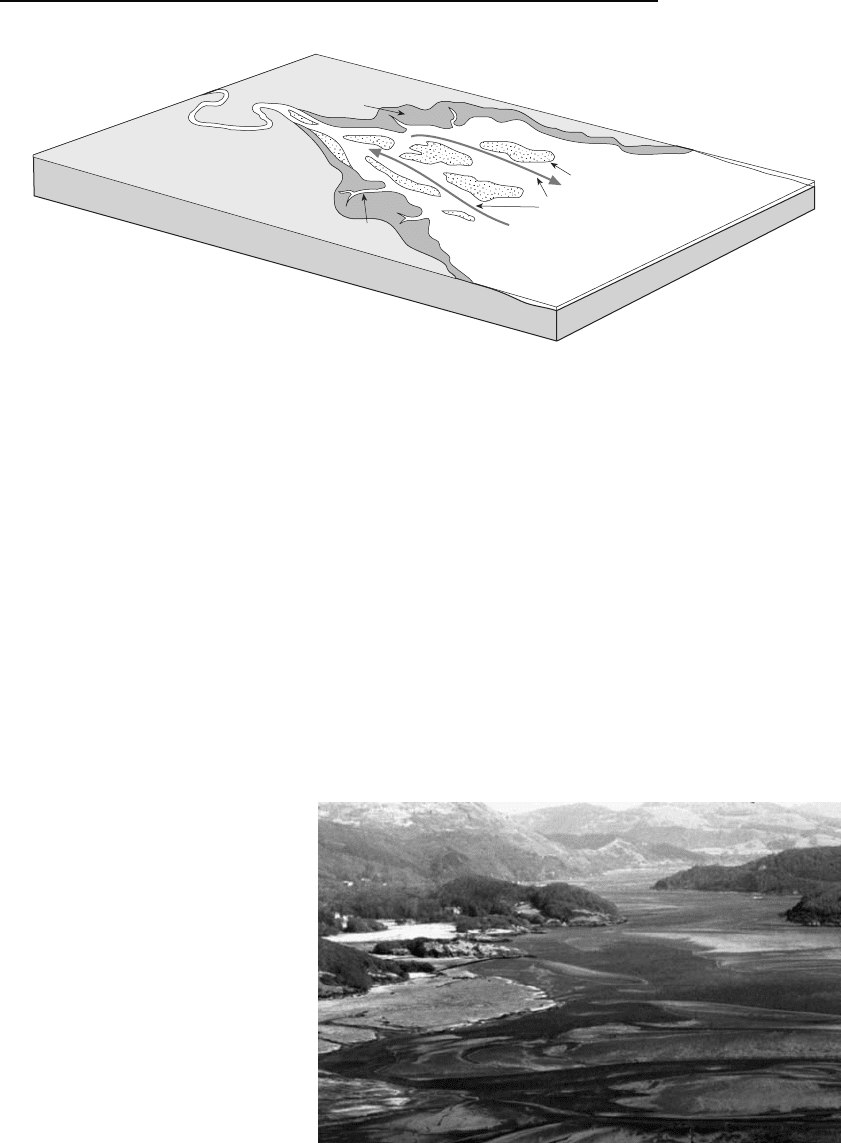
salt marsh areas cut by tidal creeks that act as the
conduits for water flow during the tidal cycles. The
processes and products of deposition in these settings
are the same as found in macrotidal settings.
Tidal bars
The outer part of a tide-dominated estuary is the
zone of strongest tidal currents, which transport
and deposit both fluvially derived sediment and mate-
rial brought in from the sea. In macrotidal regions
the currents will be strong enough to cause local
scouring and to move both sand and gravel: bioclastic
debris is common amongst the gravelly detritus depos-
ited as a lag on the channel floor (Reinson 1992). Dune
bedforms are created and migrate with the tidal
currents to generate cross-bedded sandstone beds. Evi-
dence for tidal conditions in these beds may include
mud drapes, reactivation surfaces and herringbone
cross-stratification (11.2.4). The mud drapes form as
the current slows down when the tide turns, and the
reactivation surfaces occur as opposing currents
erode the tops of dune bedforms. Herringbone cross-
bedding is relatively uncommon because the ebb and
flood tidal flows tend to follow different pathways,
with the flood tide going up one side of the estuary
and the ebb tide following a different route down the
other side. Dune bedforms that form on elongate
banks (and hence the cross-beds) will be mainly
oriented in either the flood tide direction or with the
tidal channels
river
sea
tidal sand bars
tidal mud flats
tidal creeks
tidal flow
Fig. 13.16 Distribution of depositional settings in a tidally dominated estuary.
Fig. 13.17 A tidally dominated estua-
rine environment with banks of sand
covered with dune bedforms exposed at
low tide.
Estuaries 211
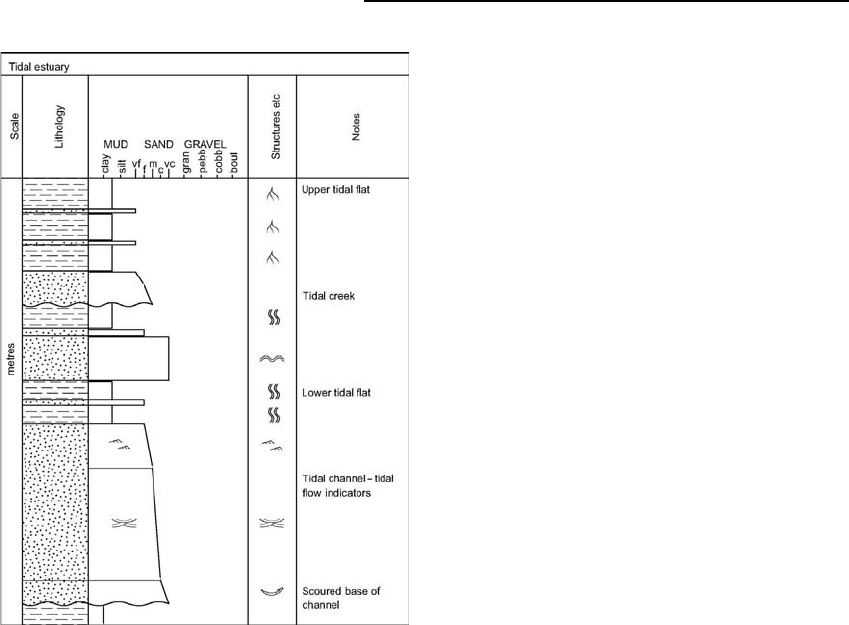
ebb tide. Herringbone cross-stratification will only
form in areas of overlap between banks of cross-beds
of different orientation, or if the currents change posi-
tion. Where tidal currents are strongest the dune bed-
forms are replaced by upper flow regime plane beds
that form horizontally laminated sands.
Successions in tide-dominated estuaries
A succession formed in a tide-dominated estuary will
consist of a combination of tidal channel, tidal flat and
tidal bar deposits. The proportions preserved of each
will depend on the position in the estuary, the strength
of the tidal currents and the amounts of mud, sand and
gravel available for deposition (Fig. 13.18). The base of
a tidal channel is marked by a scour and lag, and will
typically be followed by a fining-upwards succession of
cross-bedded sands, which may show mud drapes,
inclined heterolithic stratification. Channel and bar
deposits may also show bi-directional palaeocurrent
indicators. Muddy tidal flat deposits rich in organic
material may contain sandy sediment deposited within
tidal creeks, at the highest tides and during storms.
13.6.3 Recognition of estuarine
deposits: summary
There are many features in common between the
deposits of deltas and estuaries in the stratigraphic
record. Both are sedimentary bodies formed at the
interface between marine and continental environ-
ments and consequently display evidence of physical,
chemical and biological processes that are active in
both settings (e.g. an association of beds containing a
marine shelly fauna with other units containing root-
lets). The key difference is that a delta is a prograda-
tional sediment body, that is, it builds out into the sea
and will show a coarsening-up succession produced by
this progradation. In contrast, estuaries are mainly
aggradational, building up within a drowned river
channel. The base of an estuarine succession is there-
fore commonly an erosion surface scoured at the
mouth of the river, for example, in response to sea-
level fall. It may be difficult to distinguish between the
deposits of a tidal estuary and a tide-dominated delta if
there is limited information and it is difficult to estab-
lish whether the succession is aggradational and
valley-filling or progradational.
13.7 FOSSILS IN COASTAL AND
ESTUARINE ENVIRONMENTS
Beaches are high-energy environments, continually
washed by waves, which move the sediment around
subjecting the clasts to abrasion. The supply of shelly
material from the sea is often abundant, but much of it
will be broken up into fragments that may be identifi-
able in only a general sense as pieces of mollusc, coral,
echinoderm, etc. Only the most robust organisms
remain intact, and among these are thick-shelled mol-
luscs such as oysters, which are also found living in
high-energy, shallow water of the shallow subtidal
zone. The abundance of bioclastic debris in beach depos-
its will depend on the relative proportions of mineral
grains and shelly material supplied to the beach.
For organisms living in a lagoon, both hypersaline
and brackish conditions require adaptation that only
a limited number of plants and animals achieve.
Fig. 13.18 A graphic sedimentary log of tidal estuary
deposits.
212 Clastic Coasts and Estuaries

Lagoonal faunal and floral assemblages are therefore
often limited in numbers of taxa, being dominated by
those that are adapted to either brackish or hypersa-
line conditions. Although the diversity of fauna may
be severely limited by brackish or hypersaline waters
in the lagoon, those species that are tolerant flourish
in the absence of competition in waters rich in nutri-
ent from the surrounding vegetation. These special-
ised organisms may occur in very large numbers and
fossil assemblages in lagoons are typically of very low
diversity or even monospecific.
The traces of organisms can commonly be found
and the ichnofacies (11.7) present will depend upon
the energy of the environment and the nature of the
substrate. In lagoons the fine, organic-rich sediment
provides a favourable feeding area for organisms that
are able to tolerate the reduced/enhanced salinity,
and bioturbation may be common. In sandy intertidal
areas the predominant style of trace is typically a
vertical structure created by animals moving up to
the surface when the area is covered by water and
down within the sediment body when the water
recedes. This form of trace fossil is known as the
Skolithos assemblage, after the simple vertical tubes
that are found in these settings. Other ichnofacies
assemblages occur if the substrate is relatively firm
(Glossifungites assemblage) or hard (Trypanites assem-
blage). Trypanites-type traces are borings made in
solid rock (bedrock or loose boulders) by molluscs,
and these are characteristic of rocky coastlines.
The association of marine and continental condi-
tions is one of the characteristics of estuaries, and this
is reflected in the fossil assemblages found in deposits
in these environments. Some shelly debris may be
brought in from the marine environment, but shelly
fauna is also often abundant in estuarine settings.
As well as body fossils, evidence for biogenic activity
is also present in the form of trace fossils, which range
from very abundant and diverse in tidal mudflats to
sparse in the high energy, sandy environments of the
outer parts of estuaries. Vegetation growth may be
prolific in tidal mudflats, especially on the upper parts,
and plant remains may be present as organic material
or as root traces.
Characteristics of coastal and estuarine systems
These complex, heterogeneous depositional environ-
ments are divided into four elements for the purposes
of summarising their characteristics.
Beach/barrier systems
. lithology – sand and conglomerate
. mineralogy – mature quartz sands and shelly sands
. texture – well sorted, well rounded clasts
. bed geometry – elongate lenses
. sedimentary structures – low-angle stratification
and wave reworking
. palaeocurrents – mainly wave-formed structures
. fossils – robust shelly debris
. colour – not diagnostic
. facies associations – may be associated with coastal
plain, lagoonal or shallow-marine facies
Lagoons
. lithology – mainly mud with some sand
. mineralogy – variable
. texture – fine-grained, moderately to poorly sorted
. bed geometry – thinly bedded mud with thin sheets
and lenses of sand
. sedimentary structures – may be laminated and
wave rippled
. palaeocurrents – rare, not diagnostic
. fossils – often monospecific assemblages of hypersa-
line or brackish tolerant organisms
. colour – may be dark due to anaerobic conditions
. facies associations – may be associated with coastal
plain or beach barrier deposits
Tidal channel systems
. lithology – mud, sand and less commonly conglom-
erate
. mineralogy – variable
. texture – may be well sorted in high energy settings
. bed geometry – lenses with erosional bases
. sedimentary structures – cross-bedding and cross-
lamination and inclined heterolithic stratification
. palaeocurrents – bimodal in tidal estuaries
. fossils – shallow marine
. colour – not diagnostic
. facies associations – may be overlain by fluvial,
shallow marine, continental or delta facies
Tidal mudflats
. lithology – mud and sand
. mineralogy – clay and shelly sand
. texture – fine-grained, not diagnostic
. bed geometry – tabular muds with thin sheets and
lenses of sand
. sedimentary structures – ripple cross-lamination
and flaser/lenticular bedding
. palaeocurrents – bimodal in tidal estuaries
Fossils in Coastal and Estuarine Environments 213

. fossils – shallow marine fauna and salt marsh
vegetation
. colour – often dark due to anaerobic conditions
. facies associations – may be overlain by shallow
marine or continental facies
FURTHER READING
Boyd, R., Dalrymple, R.W. & Zaitlin, B.A. (1992) Classifica-
tion of clastic coastal depositional environments. Sedimen-
tary Geology, 80, 139–150.
Boyd, R., Dalrymple, R.W. & Zaitlin, B.A. (2006) Estuarine
and incised valley facies models. In: Facies Models Revisited
(Eds Walker, R.G. & Posamentier, H.). Special Publication
84, Society of Economic Paleontologists and Mineralogists,
Tulsa, OK; 171–235.
Clifton, H.E. (2006) A re-examination of facies models for clastic
shorelines. In: Facies Models Revisited (Eds Walker, R.G. &
Posamentier, H.). Special Publication 84, Society of Econo-
mic Paleontologists and Mineralogists, Tulsa, OK; 293–337.
Dalrymple, R.W., Zaitlin, B.A. & Boyd, R. (1992) Estuarine
facies models: conceptual basis and stratigraphic implica-
tions. Journal of Sedimentary Petrology, 62, 1130–1146.
Davis, R.A. Jr & Fitzgerald, D.M. (2004) Beaches and Coasts.
Blackwell Science, Oxford.
Reading, H.G. & Collinson, J.D. (1996) Clastic coasts. In: Sedi-
mentary Environments: Processes, Facies and Stratigraphy
(Ed. Reading, H.G.). Blackwell Science, Oxford; 154–231.
Woodroffe, C.D. (2003) Coasts: Form, Process and Evolution.
Cambridge University Press, Cambridge.
214 Clastic Coasts and Estuaries

14
Shallow Sandy Seas
Shallow marine environments are areas of accumulation of substantial amounts of
terrigenous clastic material brought in by rivers from the continental realm. Offshore
from most coastlines there is a region of shallow water, the continental shelf, which may
stretch tens to hundreds of kilometres out to sea before the water deepens down to the
abyssal depths of ocean basins. Not all land areas are separated by ocean basins, but
instead have shallow, epicontinental seas between them. Terrigenous clastic material is
distributed on shelves and epicontinental seas by tides, waves, storms and ocean
currents: these processes sort the material by grain size and deposit areas of sand and
mud, which form thick, extensive sandstone and mudstone bodies in the stratigraphic
record. Characteristic facies can be recognised as the products of transport and deposi-
tion by tides and storm/wave processes. Deposition in shallow marine environments is
sensitive to changes in sea level and the stratigraphic record of sea-level changes is
recorded within sediments formed in these settings.
14.1 SHALLOW MARINE
ENVIRONMENTS OF TERRIGENOUS
CLASTIC DEPOSITION
The continental shelves and epicontinental seas
(11.1) are important sites of deposition of sand and
mud in the world’s oceans and account for over half
the volume of ocean sediments. These successions can
be very thick, over 10,000 m, because deposition may
be very long-lived and can continue uninterrupted
for tens of millions of years. They occur as largely
undeformed strata around the edges of continents
and also in orogenic belts, where the collision of con-
tinental plates has forced beds deposited in shallow
marine environments high up into mountain ranges.
This chapter focuses on the terrigenous clastic depos-
its found in shallow seas; carbonate sedimentation,
which is also important in these environments, is
covered in Chapter 15.
14.1.1 Sediment supply to shallow seas
The supply of sediment to shelves is a fundamental
control on shallow marine environments and deposi-
tional facies of shelves and epicontinental seas. If the

area lies adjacent to an uplifted continental region
and there is a drainage pattern of rivers delivering
detritus to the coast, the shallow-marine sedi-
mentation will be dominated by terrigenous clastic
deposits. The highest concentrations of clastic sedi-
ment will be near the mouths of major rivers:
adjacent coastal regions will also be supplied with
sediment by longshore movement of material by
waves, storms and tides. Shallow seas that are not
supplied by much terrigenous material may be areas
of carbonate sedimentation, especially if they are in
lower latitudes where the climate is relatively warm.
In cooler climates where carbonate production is
slower, shelves and shallow seas with low terrigenous
sediment supply are considered to be starved. The
rate of sediment accumulation is slow and may be
exceeded by the rate of subsidence of the sea floor
such that the environment becomes gradually deeper
with time.
14.1.2 Characteristics of shallow
marine sands
Detritus that reaches a shallow sea is likely to have
had a history of transport in rivers, may have passed
through a delta or estuary, or could have been tem-
porarily deposited along a coastline before it arrives at
the shelf. If there is a long history of transport thro-
ugh these other environments the grain assemblage is
likely to be mature (2.5.3). Texturally, the grains of
sand will have suffered a degree of abrasion and the
processes of turbulent flow during transport will sepa-
rate the material into different grain sizes. The com-
positional maturity will probably be greater than the
equivalent continental deposits, because the more
labile minerals and grains (such as feldspar and lithic
fragments) are broken down during transport: shal-
low marine sands are commonly dominated by quartz
grains. In polar areas, the sediment supplied is much
less mature because cold weather reduces chemical
weathering of the grains and glacial transport does
not result in much sorting or rounding of the clasts
(7.3.4).
The detrital component is often complemented
by material that orginates in the shallow marine envi-
ronment. Shallow seas are rich in marine life, inclu-
ding many organisms that have calcareous shells and
skeletons. The remains of these biogenic hard parts
are a major component of shelf carbonate deposits
(Chapter 15), but can also be very abundant in sands
and muds deposited in these seas. Whole shells and
skeletons may be preserved in mudrocks because they
are low-energy deposits. In higher energy parts of
the sea, currents move sand around and a lot of bio-
genic debris is broken up into bioclastic fragments
ranging from sand-sized, unidentifiable pieces up to
larger pieces of shelly material and bone. Bone is
also the origin for phosphates that can form as authi-
genic deposits in shallow marine settings (3.4): these
phosphates are relatively rare. However, another
authigenic mineral, glauconite (11.5), is a common
component of sandstones and mudrocks formed
on shelves and epicontinental seas and is con-
sidered to be a reliable indicator of shallow marine
conditions. The characteristic dark green colour of
the mineral gives sediments rich in it a distinctly
green tinge, although it is iron-rich and weathers to
a rusty orange colour. ‘Greensands’ are shallow-
marine deposits rich in glauconite that are particu-
larly common in Cretaceous strata in the northern
hemisphere.
Shallow seas are environments rich in animal
life, particularly benthic organisms that can leave
traces of their activity in the sediments. Bioturbation
may form features that are recognisable of the
activities of a particular type of organism (11.7),
but also results in a general churning of the sedi-
ment, homogenising it into apparently structureless
masses. Primary sedimentary structures (wave rip-
ples, hummocky cross-stratification, trough cross-
bedding, and so on) are not always preserved in
shelf sediments because of the effects of bioturbation.
Bioturbation is most intense in shallower water and is
frequently more abundant in sandy sediment than in
muddy deposits. This is because the currents that
transport and deposit sand may also carry nutrients
for benthic organisms living in the sand: many
organisms also prefer to live on and within a sandy
substrate.
The abundance of calcareous shell material in shal-
low-marine sandstones makes calcium carbonate
available within the strata when the beds are buried.
Groundwater moving through the sediments dissolves
and reprecipitates the carbonate as cement (18.2.2).
Shelly fossils within sandstones are therefore some-
times found only as casts of the original form, as the
original calcite or aragonite shells have been dissolved
away. Sandstone beds deposited in shallow marine
settings also typically have a calcite cement.
216 Shallow Sandy Seas
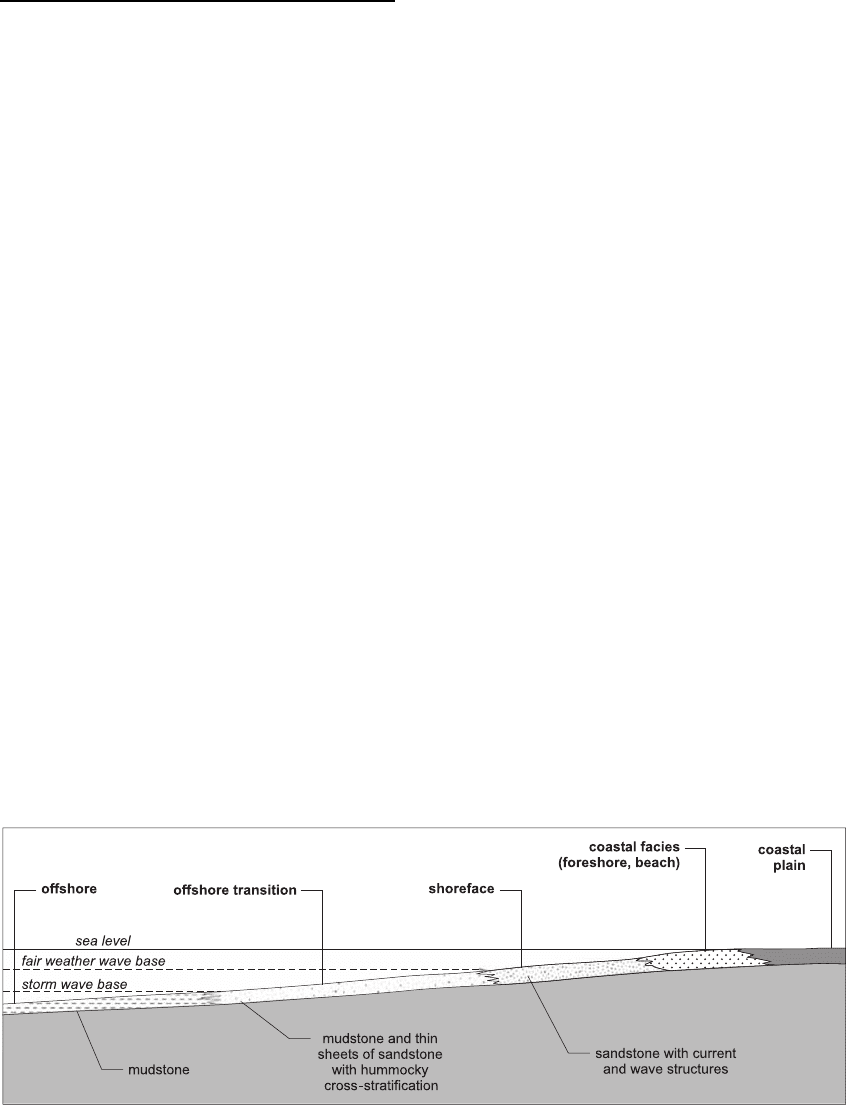
14.1.3 Shallow marine clastic environments
The patterns and characteristics of deposition on
shelves and epicontinental seas with abundant terrige-
nous clastic supply are controlled by the relative impor-
tance of wave, storm and tidal processes. The largest
tidal ranges tend to be in epicontinental seas and
restricted parts of shelves, although in some situations
the tidal ranges in narrow or restricted seaways
can be very small (11.2.2). Open shelf areas facing
oceans are typically regions with a microtidal to
mesotidal regime and are affected by ocean storms.
Two main types, storm-dominated shelves and
tide-dominated shelves, can be recognised in both
modern environments and ancient facies: these are
end-members of a continuum and many modern
and ancient shelves and epicontinental seas show
influence of both major processes (Johnson & Baldwin
1996). The majority of modern shelves are storm-
dominated (80%): the remainder are mainly tide-
dominated (17%), with just a small number (3%) of
shelves influenced mainly by ocean currents (Johnson
& Baldwin 1996). These ocean-current-dominated
shelves are generally narrow (less than 10 km) and
lie adjacent to strong geostrophic currents (11.4):
sandwaves and sand ribbons form on them, and as
such they are similar to tidal shelves, but the driving
current is not of tidal origin.
The detailed characteristics of sands deposited on
modern shelves can be determined directly only by
taking shallow cores that provide a limited amount
of information: indirect investigation by geophysical
techniques, such as shallow seismic profiles (22.2),
can also yield some information about the internal
structures. Not all sandy deposits occurring on mod-
ern shelves have been formed by processes occurring
in the present day: the sea-level rise in the past 10 kyr,
the Holocene transgression, has drowned former
strand plain and barrier island ridges, along with
sands deposited in the shoreface, leaving them as
inactive relics in deeper water.
14.2 STORM-DOMINATED SHALLOW
CLASTIC SEAS
14.2.1 Facies distribution across
a storm-dominated shelf
Shoreface
The shallower parts of the shelf and epicontinental sea
are within the depth zone for wave action (11.1) and
any sediment will be extensively reworked by wave
processes. Sands deposited in these settings may pre-
serve wave-ripple cross-lamination and horizontal
stratification. Streaks of mud in flaser beds (4.8) depos-
ited during intervals of lower wave energy become
more common in the deposits of slightly deeper
water further offshore (Fig. 14.1). Wave ripples are
less common as the fair-weather wave base is
approached in the lower part of the shoreface. Within
the shoreface zone sand ridges may be formed by
flows generated by eddy currents related to storms
and/or wave-driven longshore drift (Stubblefield
et al. 1984). These ridges occur in water depths of
5 to 15 m and are oriented obliquely to the coastline
as oblique longshore bars. They are up to about 10 m
Fig. 14.1 Characteristics of a storm-dominated shelf environment.
Storm-dominated Shallow Clastic Seas 217
